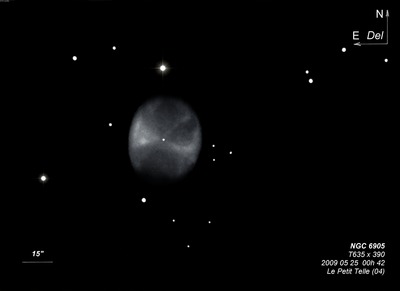Blue Flash Nebula
Blue Flash Nebula

William Herschel discovered NGC 6905 = H IV-16 = h2075 on 16 Sep 1784 (sweep 275) and recorded "pB, perfectly R, pretty well defined, about 3' in diameter." The next night he noted "I do not doubt but it consists of very much compressed stars." His size estimate was much too large, but his position is just 6 seconds too far west. JH made 3 observations and logged on sweep 364, "Fine planetary nebula; B; exactly R; rather hazy at the edges, but not materially brighter in the middle, but no hollow. It has four small stars near it like satellites." The nearby stars were micrometrically measured as the possibility of physical satellites of planetaries intrigued JH and he mentioned it regarding NGC 6818 and 7662.
On 10 Aug 1850 Lord Rosse's assistant reported, "* or B nucl nf the middle. A dark curved line p[receding] this plainly seen, which at moments I fancied went round the sf part". Two years later, George Johnstone Stoney stated "this planetary nebela is a beautiful little spiral". This is a case of imagined spiral structure as it was a primary focus at Birr Castle. R.J. Mitchell's sketch from 12 Aug 1855 with a spiral appearance was included in the 1861 publication (Plate XXVIII, figure 34). Father Secchi noted a bi-polar brightening or mottling, particularly on the east side (1856, 9.5" refractor). Vogel made an excellent sketch of the planetary in Sep 1883 with the 27" Vienna refractor with a dark lane oriented ~N-S, tapering towards the central star and two brighter triangular "wings" on the east and west side, with the eastern wing more prominent.
Based on Crossley photographs taken at Lick, Heber Curtis (1918) reported "the main portion is a very patchy truncated ellipse 44"x37" in p.a. 163°. Very faint cone-shaped ansae extend from each end. A star of mag 12 lies nearly at the end of the southern ansa."
John Mallas coined the nickname "Blue Flash" in his Aug/Sep 1963 article "Visual Atlas of Planetary Nebulae-VI", published in the "Review of Popular Astronomy". He described NGC 6905 as "The Blue Flash. After turning a telescope on this object one will notice the small triangle of stars superimposed upon it. Glimmering and flashing between the triangle is the little planetary. Using about 120x on a 4-inch reveals all that can be seen in small apertures."
200/250mm - 8" (6/29/84): moderately bright, uniform, slightly elongated N-S, two stars at the northeast and south edge.
400/500mm - 17.5" (8/31/86): very pretty planetary at 280x. Fairly bright, fairly small, slightly elongated. A very faint central star (V = 15.7) is visible. Takes 440x well. Just off the north edge is a mag 11 star 1.4' from center and a mag 12 star is just off the south edge 39" from center.
600/800mm - 24" (8/14/15): the "Blue Flash" planetary was observed at 500x and 750x in excellent seeing. The main body is oval 5:4 NNW-SSE, ~48"x40" and annular. The rim appeared brightest along a thin strip on the east side and enhanced in a slightly brighter triangular wedge (roughly 60°-80°) extending east from the mag 15.7 central star. The opposite western rim was also brighter, but the north and south ends as not enhanced. The interior was mottled with a slightly darker, irregular central "hole", particularly on the south and west side of the central star, but not to the east. Mag 10.4 HD 352100 lies 48" N of center and a mag 12 star is 38" SSE of center, in the direction of the major axis.
An extremely faint outer halo or wing was occasionally glimpsed off the north-northwest end, tapering in the direction of the major axis and extending 10"-12" in length. The corresponding extension off the south-southeast side and ending at the mag 12 star (completing a lens-shaped outline out of a truncated ellipse on deep images) was not seen, although Jimi Lowrey felt it was equally visible.
900/1200mm - 48" (5/16/12): beautiful blue oval planetary with a fairly bright central star. Very nice annular appearance with an irregular darker interior. A bright arc is along the east or northeast rim and a slightly weaker counterpart was on the west or southwest edge. The ends are somewhat chopped off, creating a rectangular appearance.
Notes by Steve Gottlieb